Dynamic and Thermodynamic Drivers of Severe Sub-Hourly Precipitation Events in Mainland Portugal
Abstract
:1. Introduction
2. Materials and Methods
2.1. Observational Data
2.2. ERA5 Reanalysis Data
2.3. Instability Indices and Potential Temperature
2.4. Categorisation of Sub-Hourly Precipitation
2.5. Composites
3. Results
3.1. Observational Data and Precipitation Classes
3.2. Synoptic Atmospheric Dynamics
3.3. Atmospheric Instability Indices
4. Discussion
5. Conclusions
Supplementary Materials
Author Contributions
Funding
Institutional Review Board Statement
Informed Consent Statement
Data Availability Statement
Acknowledgments
Conflicts of Interest
References
- Nielsen, E.R.; Schumacher, R.S. Dynamical insights into extreme short-term precipitation associated with supercells and mesovortices. J. Atmos. Sci. 2018, 75, 2983–3009. [Google Scholar] [CrossRef]
- Fragoso, M.; Trigo, R.M.; Pinto, J.G.; Lopes, S.; Lopes, A.; Ulbrich, S.; Magro, C. The 20 February 2010 Madeira flash-floods: Synoptic analysis and extreme rainfall assessment. Nat. Hazards Earth Syst. Sci. 2012, 12, 715–730. [Google Scholar] [CrossRef]
- Fernández-Nóvoa, D.; González-Cao, J.; Figueira, J.R.; Catita, C.; García-Feal, O.; Gómez-Gesteira, M.; Trigo, R.M. Numerical simulation of the deadliest flood event of Portugal: Unravelling the causes of the disaster. Sci. Total Environ. 2023, 896, 165092. [Google Scholar] [CrossRef] [PubMed]
- Trigo, R.M.; Ramos, C.; Pereira, S.S.; Ramos, A.M.; Zêzere, J.L.; Liberato, M.L.R. The deadliest storm of the 20th century striking Portugal: Flood impacts and atmospheric circulation. J. Hydrol. 2016, 541, 597–610. [Google Scholar] [CrossRef]
- Deierling, W.; Petersen, W.A.; Latham, J.; Ellis, S.; Christian, H.J. The relationship between lightning activity and ice fluxes in thunderstorms. J. Geophys. Res. Atmos. 2008, 113, D15210. [Google Scholar] [CrossRef]
- Petrucci, O.; Aceto, L.; Bianchi, C.; Bigot, V.; Brázdil, R.; Pereira, S.; Kahraman, A.; Kiliç, Ö.; Kotroni, V.; Llasat, M.C.; et al. Flood fatalities in Europe, 1980-2018: Variability, features, and lessons to learn. Water 2019, 11, 1682. [Google Scholar] [CrossRef]
- Gaume, E.; Bain, V.; Bernardara, P.; Newinger, O.; Barbuc, M.; Bateman, A.; Blaškovičová, L.; Blöschl, G.; Borga, M.; Dumitrescu, A.; et al. A compilation of data on European flash floods. J. Hydrol. 2009, 367, 70–78. [Google Scholar] [CrossRef]
- Rochette, S.M.; Moore, J.T. Initiation of an elevated mesoscale convective system associated with heavy rainfall. Weather Forecast. 1996, 11, 443–457. [Google Scholar] [CrossRef]
- Mahale, V.N.; Zhang, G.; Xue, M. Characterization of the 14 June 2011 Norman, Oklahoma, downburst through dual-polarization radar observations and hydrometeor classification. J. Appl. Meteorol. Climatol. 2016, 55, 2635–2655. [Google Scholar] [CrossRef]
- Santos, J.A.; Belo-Pereira, M. Sub-Hourly Precipitation Extremes in Mainland Portugal and Their Driving Mechanisms. Climate 2022, 10, 28. [Google Scholar] [CrossRef]
- Mathias, L.; Ermert, V.; Kelemen, F.D.; Ludwig, P.; Pinto, J.G. Synoptic analysis and hindcast of an intense bow echo in western Europe: The 9 June 2014 storm. Weather Forecast. 2017, 32, 1121–1141. [Google Scholar] [CrossRef]
- Pinto, P.; Belo-Pereira, M. Damaging convective and non-convective winds in Southwestern Iberia during windstorm xola. Atmosphere 2020, 11, 692. [Google Scholar] [CrossRef]
- Skamarock, W.C. Evaluating mesoscale NWP models using kinetic energy spectra. Mon. Weather Rev. 2004, 132, 3019–3032. [Google Scholar] [CrossRef]
- Pereira, S.C.; Carvalho, D.; Rocha, A. Temperature and precipitation extremes over the iberian peninsula under climate change scenarios: A review. Climate 2021, 9, 139. [Google Scholar] [CrossRef]
- North, R.; Trueman, M.; Mittermaier, M.; Rodwell, M.J. An assessment of the SEEPS and SEDI metrics for the verification of 6h forecast precipitation accumulations. Meteorol. Appl. 2013, 20, 164–175. [Google Scholar] [CrossRef]
- Santos, J.A.; Belo-Pereira, M. A comprehensive analysis of hail events in Portugal: Climatology and consistency with atmospheric circulation. Int. J. Climatol. 2019, 39, 188–205. [Google Scholar] [CrossRef]
- Sousa, J.F.; Fragoso, M.; Mendes, S.; Corte-Real, J.; Santos, J.A. Statistical-dynamical modeling of the cloud-to-ground lightning activity in Portugal. Atmos. Res. 2013, 132–133, 46–64. [Google Scholar] [CrossRef]
- Peel, M.C.; Finlayson, B.L.; McMahon, T.A. Updated world map of the Köppen-Geiger climate classification. Hydrol. Earth Syst. Sci. 2007, 11, 1633–1644. [Google Scholar] [CrossRef]
- Trıgo, R.M.; Da Câmara, C.C. Circulation weather types and their influence on the precipitatıon regime in Portugal. Int. J. Climatol. 2000, 20, 1559–1581. [Google Scholar] [CrossRef]
- Hoinka, K.P.; De Castro, M. The Iberian Peninsula thermal low. Q. J. R. Meteorol. Soc. 2003, 129, 1491–1511. [Google Scholar] [CrossRef]
- Amorim Ferreira, H. Characterisation of air masses over Portugal. In Memórias do Serviço Meteorológico 35; Serviço Meteorologico de Angola: Lisbon, Portugal, 1954. [Google Scholar]
- Woollings, T.; Pinto, J.G.; Santos, J.A. Dynamical evolution of North Atlantic ridges and Poleward Jet stream displacements. J. Atmos. Sci. 2011, 68, 954–963. [Google Scholar] [CrossRef]
- Santos, J.A.; Woollings, T.; Pinto, J.G. Are the winters 2010 and 2012 archetypes exhibiting extreme opposite behavior of the north atlantic jet stream. Mon. Weather Rev. 2013, 141, 3626–3640. [Google Scholar] [CrossRef]
- Nieto, R.; Gimeno, L.; Añel, J.A.; De la Torre, L.; Gallego, D.; Barriopedro, D.; Gallego, M.; Gordillo, A.; Redaño, A.; Delgado, G. Analysis of the precipitation and cloudiness associated with COLs occurrence in the Iberian Peninsula. Meteorol. Atmos. Phys. 2007, 96, 103–119. [Google Scholar] [CrossRef]
- Belo-Pereira, M.; Dutra, E.; Viterbo, P. Evaluation of global precipitation data sets over the Iberian Peninsula. J. Geophys. Res. Atmos. 2011, 116, D20101. [Google Scholar] [CrossRef]
- Soares, P.M.M.; Cardoso, R.M.; Miranda, P.M.A.; de Medeiros, J.; Belo-Pereira, M.; Espirito-Santo, F. WRF high resolution dynamical downscaling of ERA-Interim for Portugal. Clim. Dyn. 2012, 39, 2497–2522. [Google Scholar] [CrossRef]
- Van Delden, A. The synoptic setting of thunderstorms in Western Europe. Atmos. Res. 2001, 56, 89–110. [Google Scholar] [CrossRef]
- Peppler, R.A.; Lamb, P.J. Tropospheric Static Stability and Central North American Growing Season Rainfall. Mon. Weather Rev. 1989, 117, 1156–1180. [Google Scholar] [CrossRef]
- Meyer, J.; Neuper, M.; Mathias, L.; Zehe, E.; Pfister, L. Atmospheric conditions favouring extreme precipitation and flash floods in temperate regions of Europe. Hydrol. Earth Syst. Sci. 2022, 26, 6163–6183. [Google Scholar] [CrossRef]
- Junker, N.W.; Schneider, R.S.; Fauver, S.L. A study of heavy rainfall events during the great midwest flood of 1993. Weather Forecast. 1999, 14, 701–712. [Google Scholar] [CrossRef]
- Nieto, R.; Gimeno, L.; de La Torre, L.; Ribera, P.; Gallego, D.; García-Herrera, R.; García, J.A.; Nuñez, M.; Redaño, A.; Lorente, J. Climatological features of cutoff low systems in the Northern Hemisphere. J. Clim. 2005, 18, 3085–3103. [Google Scholar] [CrossRef]
- Ferreira, R.N. Cut-off lows and extreme precipitation in eastern spain: Current and future climate. Atmosphere 2021, 12, 835. [Google Scholar] [CrossRef]
- Santos, M.; Fragoso, M.; Santos, J.A. Regionalization and susceptibility assessment to daily precipitation extremes in mainland Portugal. Appl. Geogr. 2017, 86, 128–138. [Google Scholar] [CrossRef]
- Hersbach, H.; Bell, B.; Berrisford, P.; Hirahara, S.; Horányi, A.; Muñoz-Sabater, J.; Nicolas, J.; Peubey, C.; Radu, R.; Schepers, D.; et al. The ERA5 global reanalysis. Q. J. R. Meteorol. Soc. 2020, 146, 1999–2049. [Google Scholar] [CrossRef]
- Hacker, J.; Draper, C.; Madaus, L. Challenges and opportunities for data assimilation in mountainous environments. Atmosphere 2018, 9, 127. [Google Scholar] [CrossRef]
- Hersbach, H.; Bell, B.; Berrisford, P.; Biavati, G.; Horányi, A.; Muñoz Sabater, J.; Nicolas, J.; Peubey, C.; Radu, R.; Rozum, I.; et al. ERA5 Hourly Data on Single Levels from 1940 to Present. Available online: https://cds.climate.copernicus.eu/cdsapp#!/dataset/reanalysis-era5-single-levels?tab=overview (accessed on 18 May 2023).
- Hersbach, H.; Bell, B.; Berrisford, P.; Biavati, G.; Horányi, A.; Muñoz Sabater, J.; Nicolas, J.; Peubey, C.; Radu, R.; Rozum, I.; et al. ERA5 Hourly Data on Pressure Levels from 1940 to Present. Available online: https://cds.climate.copernicus.eu/cdsapp#!/dataset/reanalysis-era5-pressure-levels?tab=overview (accessed on 18 May 2023).
- Kunz, M. The skill of convective parameters and indices to predict isolated and severe thunderstorms. Nat. Hazards Earth Syst. Sci. 2007, 7, 327–342. [Google Scholar] [CrossRef]
- Belo-Pereira, M.; Andrade, C.; Pinto, P. A long-lived tornado on 7 December 2010 in mainland Portugal. Atmos. Res. 2017, 185, 202–215. [Google Scholar] [CrossRef]
- DeRubertis, D. Recent trends in four common stability indices derived from US radiosonde observations. J. Clim. 2006, 19, 309–323. [Google Scholar] [CrossRef]
- Kirkpatrick, C.; McCaul, E.W.; Cohen, C. Variability of updraft and downdraft characteristics in a large parameter space study of convective storms. Mon. Weather Rev. 2009, 137, 1550–1561. [Google Scholar] [CrossRef]
- Bluestein, H.B.; Jain, M.H. Formation of mesoscale lines of pirecipitation: Severe squall lines in Oklahoma during the spring. J. Atmos. Sci. 1985, 42, 1711–1732. [Google Scholar] [CrossRef]
- Rochette, S.M.; Moore, J.T.; Market, P.S. The importance of parcel choice in elevated CAPE computations. Natl. Wea. Dig. 1999, 23, 20–32. [Google Scholar]
- Blanchard, D.O. Assessing the vertical distribution of convective available potential energy. Weather Forecast. 1998, 13, 870–877. [Google Scholar] [CrossRef]
- López, L.; Marcos, J.L.; Sanchez, J.L.; Castro, A.; Fraile, R. CAPE values and hailstorms on northwestern Spain. Atmos. Res. 2001, 56, 147–160. [Google Scholar] [CrossRef]
- Kaltenböck, R.; Diendorfer, G.; Dotzek, N. Evaluation of thunderstorm indices from ECMWF analyses, lightning data and severe storm reports. Atmos. Res. 2009, 93, 381–396. [Google Scholar] [CrossRef]
- González-Rojí, S.J.; Carreno-Madinabeitia, S.; Sáenz, J.; Ibarra-Berastegi, G. Changes in the simulation of instability indices over the Iberian Peninsula due to the use of 3DVAR data assimilation. Hydrol. Earth Syst. Sci. Discuss. 2020, 2020, 1–25. [Google Scholar]
- Groenemeijer, P.; Púčik, T.; Tsonevsky, I.; Bechtold, P. An Overview of Convective Available Potential Energy and Convective Inhibition Provided by NWP Models for Operational Forecasting; ECMWF Technical Memoranda; ECMWF: Reading, UK, 2019; pp. 1–19. [Google Scholar]
- Lock, N.A.; Houston, A.L. Empirical examination of the factors regulating thunderstorm initiation. Mon. Weather Rev. 2014, 142, 240–258. [Google Scholar] [CrossRef]
- Owens, R.; Hewson, T. ECMWF Forecast User Guide; ECMWF: Reading, UK, 2018. [Google Scholar]
- Siedlecki, M. Selected instability indices in Europe. Theor. Appl. Climatol. 2009, 96, 85–94. [Google Scholar] [CrossRef]
- Iturrioz, I.; Hernández, E.; Ribera, P.; Queralt, S. Instability and its relation to precipitation over the Eastern Iberian Peninsula. Adv. Geosci. 2007, 10, 45–50. [Google Scholar] [CrossRef]
- Letestu, S. International Meteorological Tables; World Meteor Organization: Geneva, Switzerland, 1966. [Google Scholar]
- Santos, J.A.; Corte-Real, J.; Leite, S.M. Weather regimes and their connection to the winter rainfall in Portugal. Int. J. Climatol. 2005, 25, 33–50. [Google Scholar] [CrossRef]
- Yun, B.I.; Rim, K.S. Construction of Lanczos type filters for the Fourier series approximation. Appl. Numer. Math. 2009, 59, 280–300. [Google Scholar] [CrossRef]
- Hénin, R.; Liberato, M.L.R.; Ramos, A.M.; Gouveia, C.M. Assessing the use of satellite-based estimates and high-resolution precipitation datasets for the study of extreme precipitation events over the Iberian Peninsula. Water 2018, 10, 1688. [Google Scholar] [CrossRef]
- Durran, D.R.; Snellman, L.W. The diagnosis of synoptic-scale vertical motion in an operational environment. Weather Forecast. 1987, 2, 17–31. [Google Scholar] [CrossRef]
- Hoskins, B.; Pedder, M.; Jones, D.W. The omega equation and potential vorticity. Q. J. R. Meteorol. Soc. A J. Atmos. Sci. Appl. Meteorol. Phys. Oceanogr. 2003, 129, 3277–3303. [Google Scholar] [CrossRef]
- He, C. Future Drying Subtropical East Asia in Winter: Mechanism and Observational Constraint. J. Clim. 2023, 36, 2985–2998. [Google Scholar] [CrossRef]
- Palmén, E.; Newton, C.W. Atmospheric Circulation Systems: Their Structure and Physical Interpretation; Academic Press: Cambridge, MA, USA, 1969; ISBN 0125445504. [Google Scholar]
- Winkler, R.; Zwatz-Meise, V. Manual of Synoptic Satellite Meteorology; Concept. Model. Vers. 6; 2001. Available online: http://www.zamg.ac.at/docu/Manual/SatManu/main.htm (accessed on 23 July 2023).
- Bringi, V.N.; Chandrasekar, V. Polarimetric Doppler Weather Radar: Principles and Applications; Cambridge University Press: Cambridge, UK, 2001; ISBN 0521623847. [Google Scholar]
- Hu, G.; Dance, S.L.; Bannister, R.N.; Chipilski, H.G.; Guillet, O.; Macpherson, B.; Weissmann, M.; Yussouf, N. Progress, challenges, and future steps in data assimilation for convection-permitting numerical weather prediction: Report on the virtual meeting held on 10 and 12 November 2021. Atmos. Sci. Lett. 2023, 24, e1130. [Google Scholar] [CrossRef]
- McNulty, R.P. Severe and convective weather: A central region forecasting challenge. Weather Forecast. 1995, 10, 187–202. [Google Scholar] [CrossRef]
- Doswell, C.A.; Brooks, H.E.; Maddox, R.A. Flash flood forecasting: An ingredients-based methodology. Weather Forecast. 1996, 11, 560–581. [Google Scholar] [CrossRef]
- Ramos, A.M.; Trigo, R.M.; Liberato, M.L.R. A ranking of high-resolution daily precipitation extreme events for the Iberian Peninsula. Atmos. Sci. Lett. 2014, 15, 328–334. [Google Scholar] [CrossRef]
- Durao, R.M.; Pereira, M.J.; Costa, A.C.; Delgado, J.; Del Barrio, G.; Soares, A. Spatial–temporal dynamics of precipitation extremes in southern Portugal: A geostatistical assessment study. Int. J. Climatol. 2010, 30, 1526–1537. [Google Scholar] [CrossRef]
- Santos, M.; Fonseca, A.; Fragoso, M.; Santos, J.A. Recent and future changes of precipitation extremes in mainland Portugal. Theor. Appl. Climatol. 2019, 137, 1305–1319. [Google Scholar] [CrossRef]
- Doswell, C.A., III; Rasmussen, E.N. The effect of neglecting the virtual temperature correction on CAPE calculations. Weather Forecast. 1994, 9, 625–629. [Google Scholar] [CrossRef]
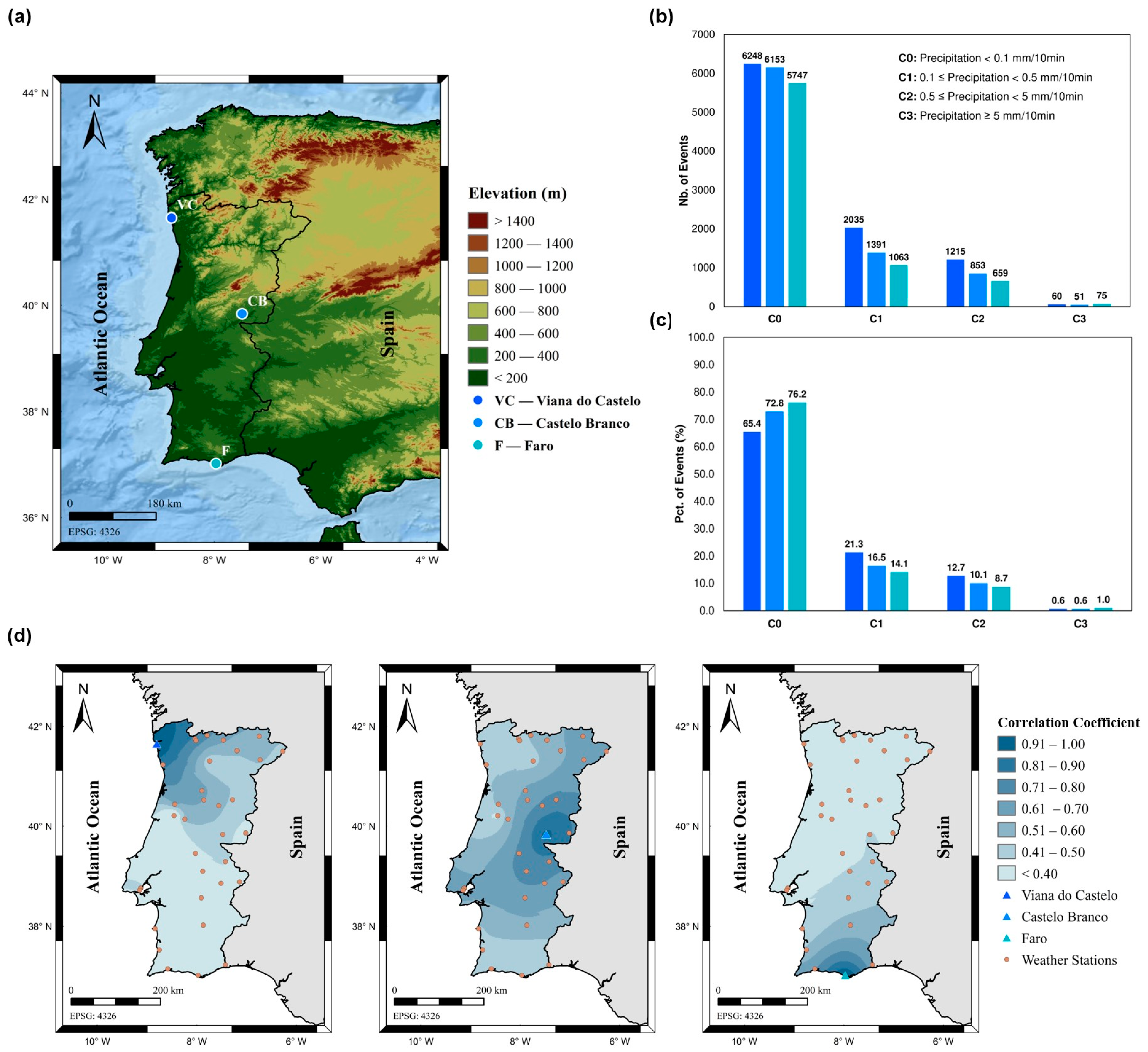
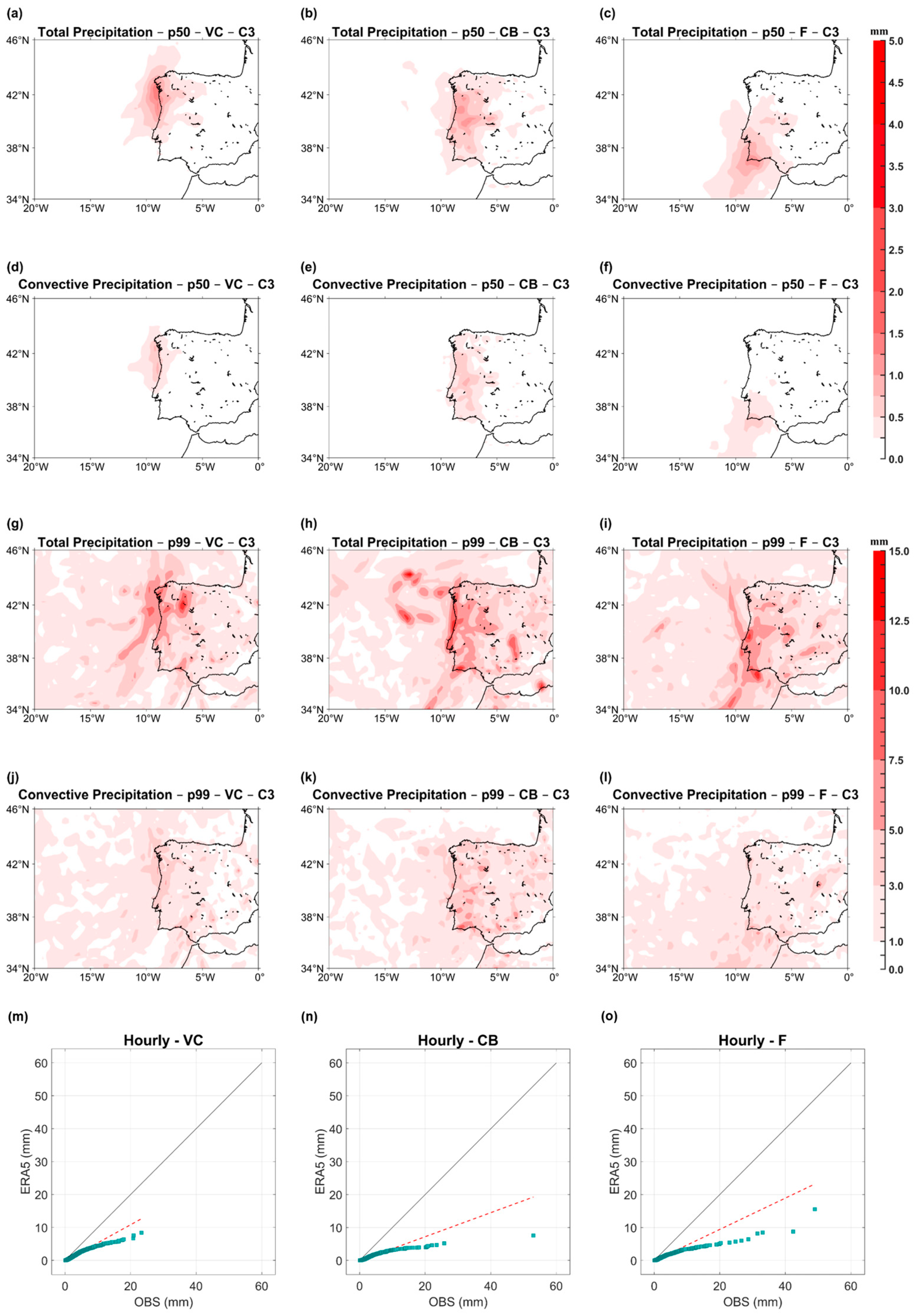
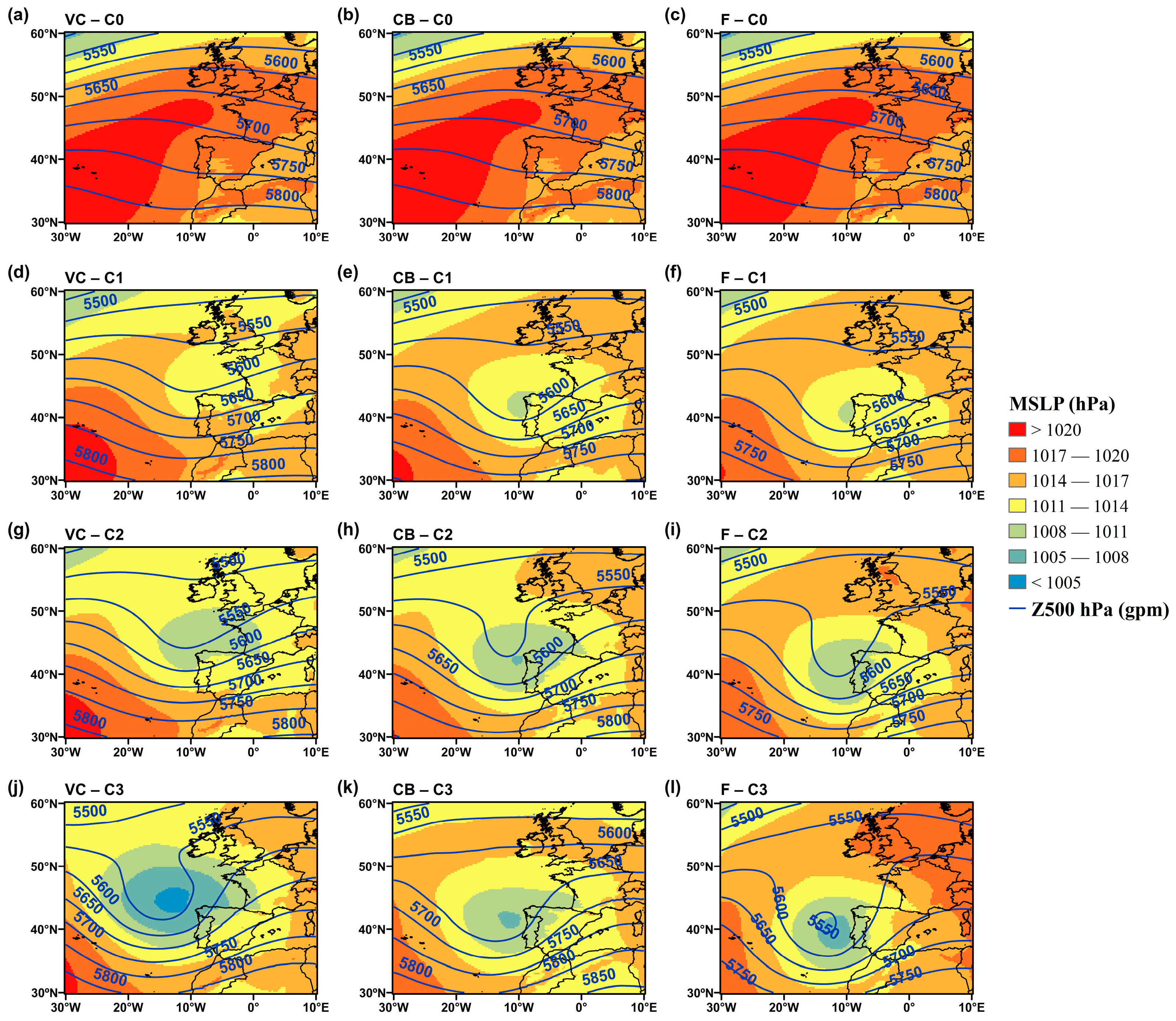
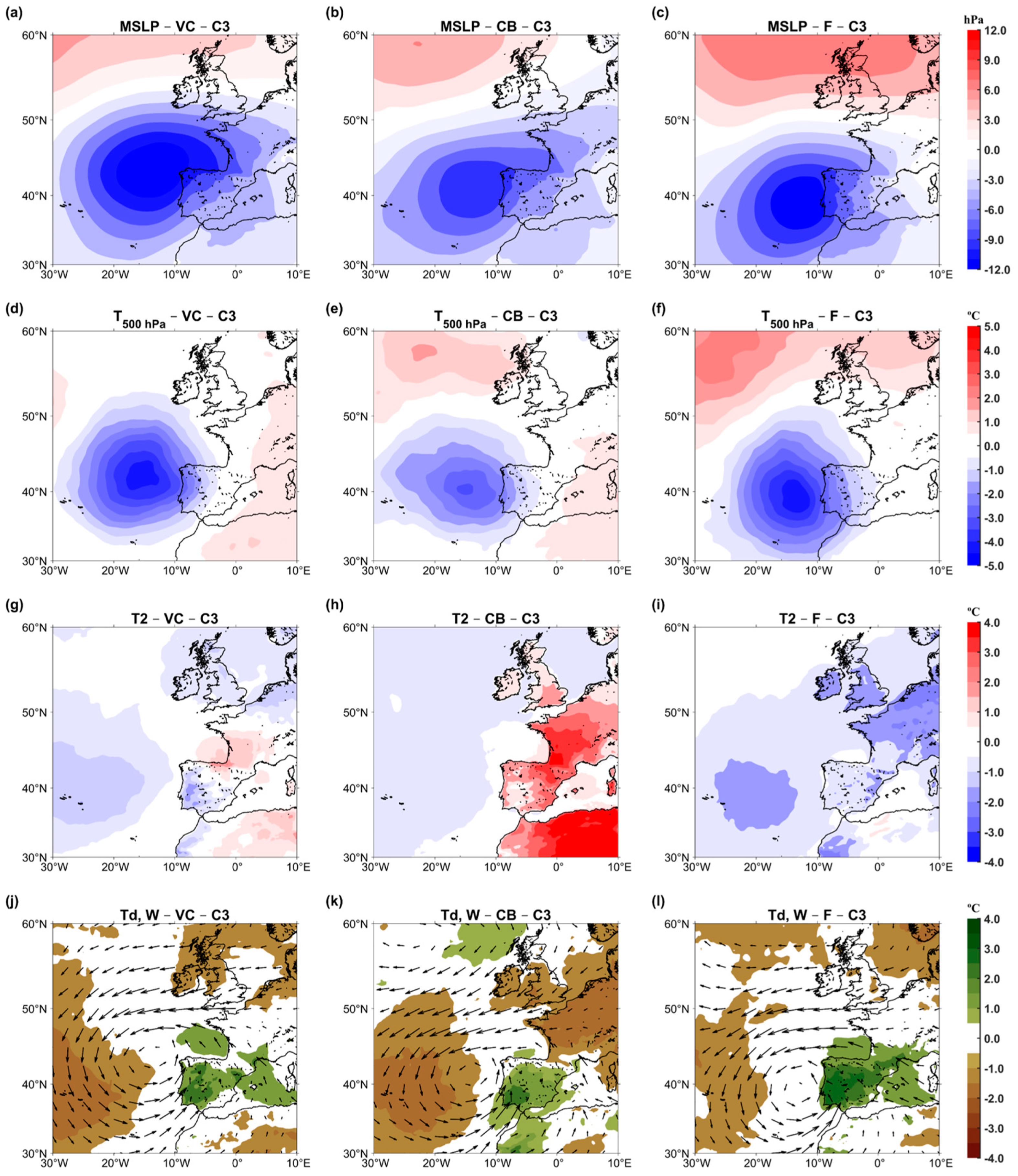

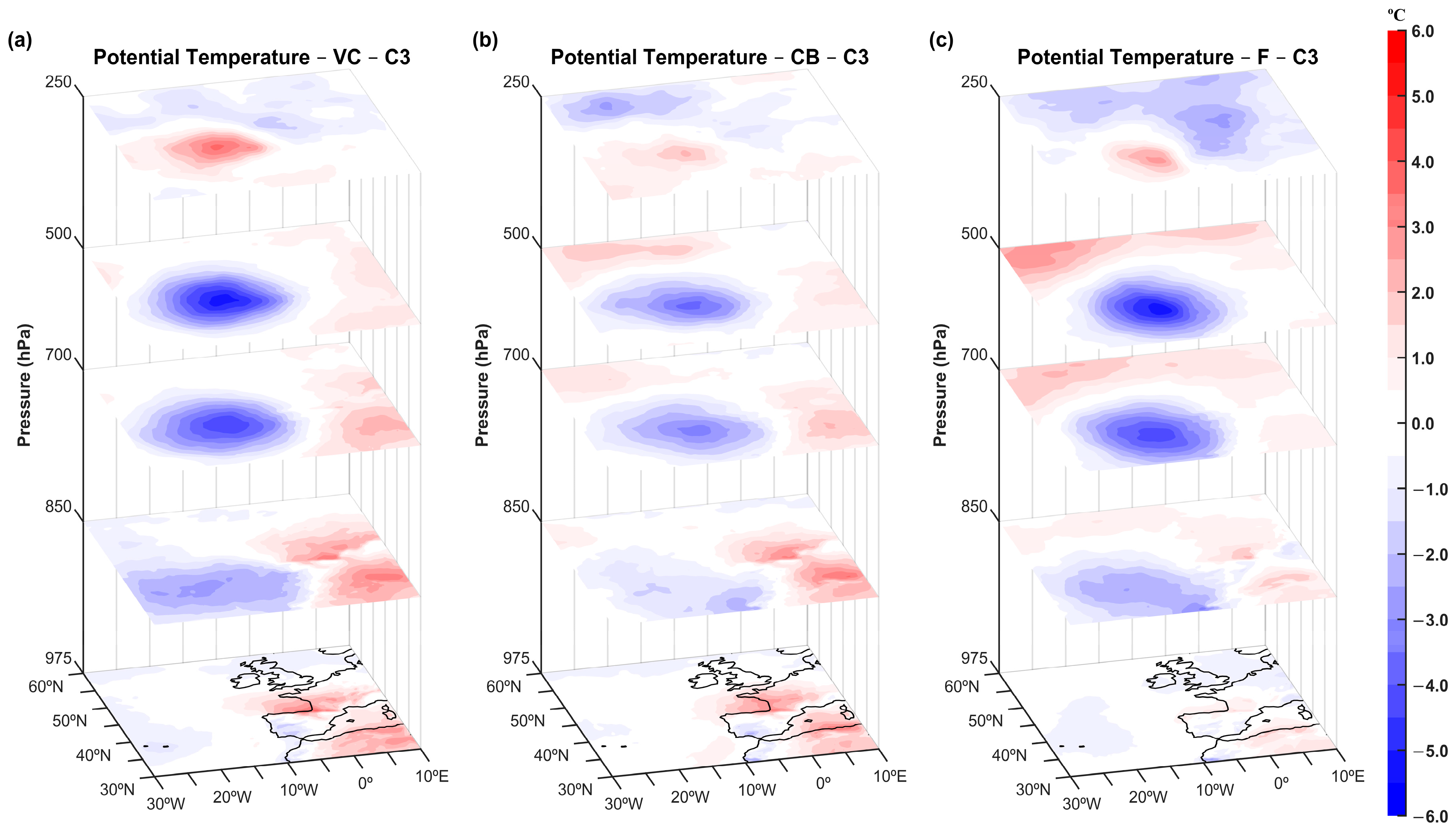

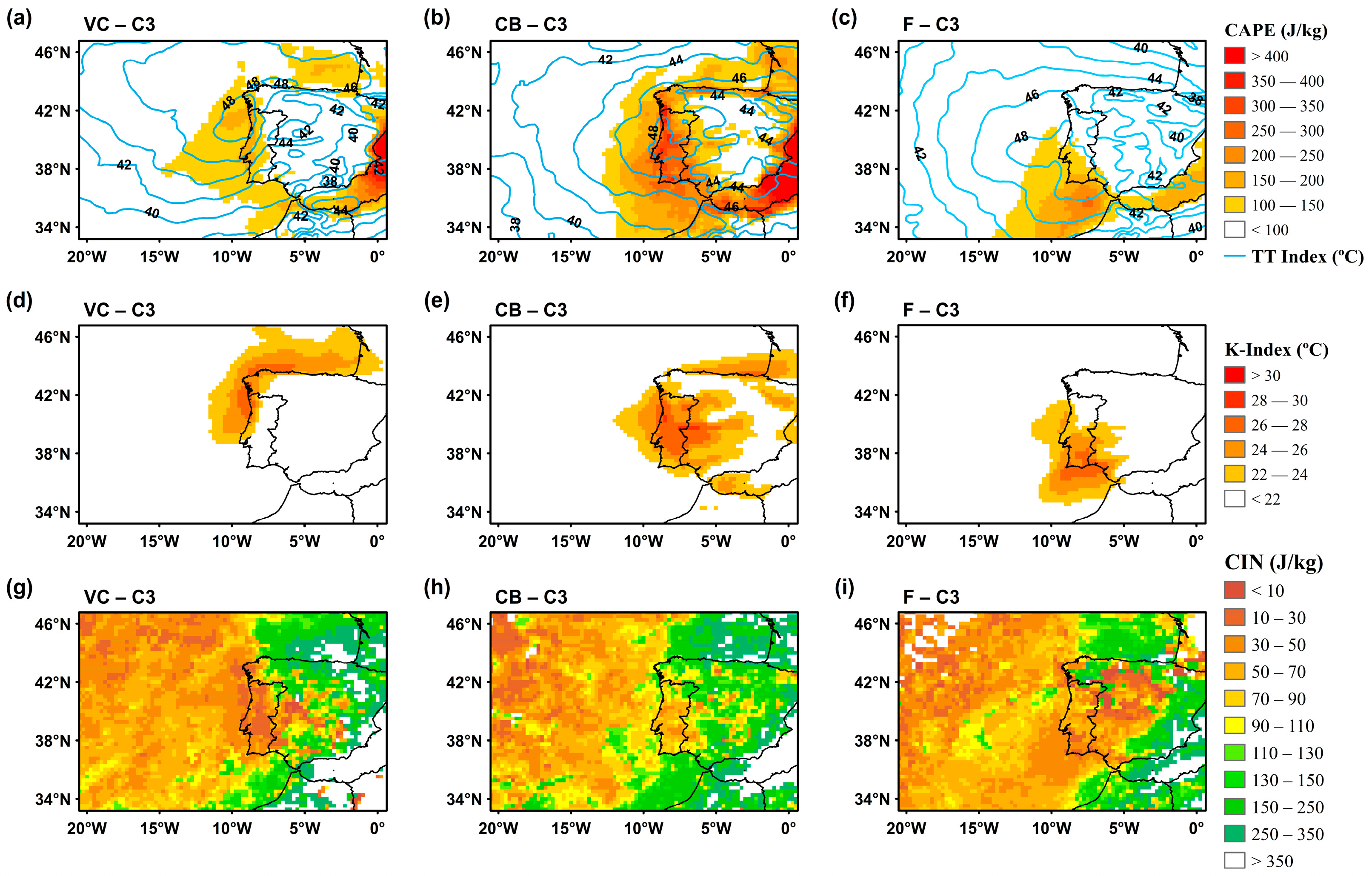
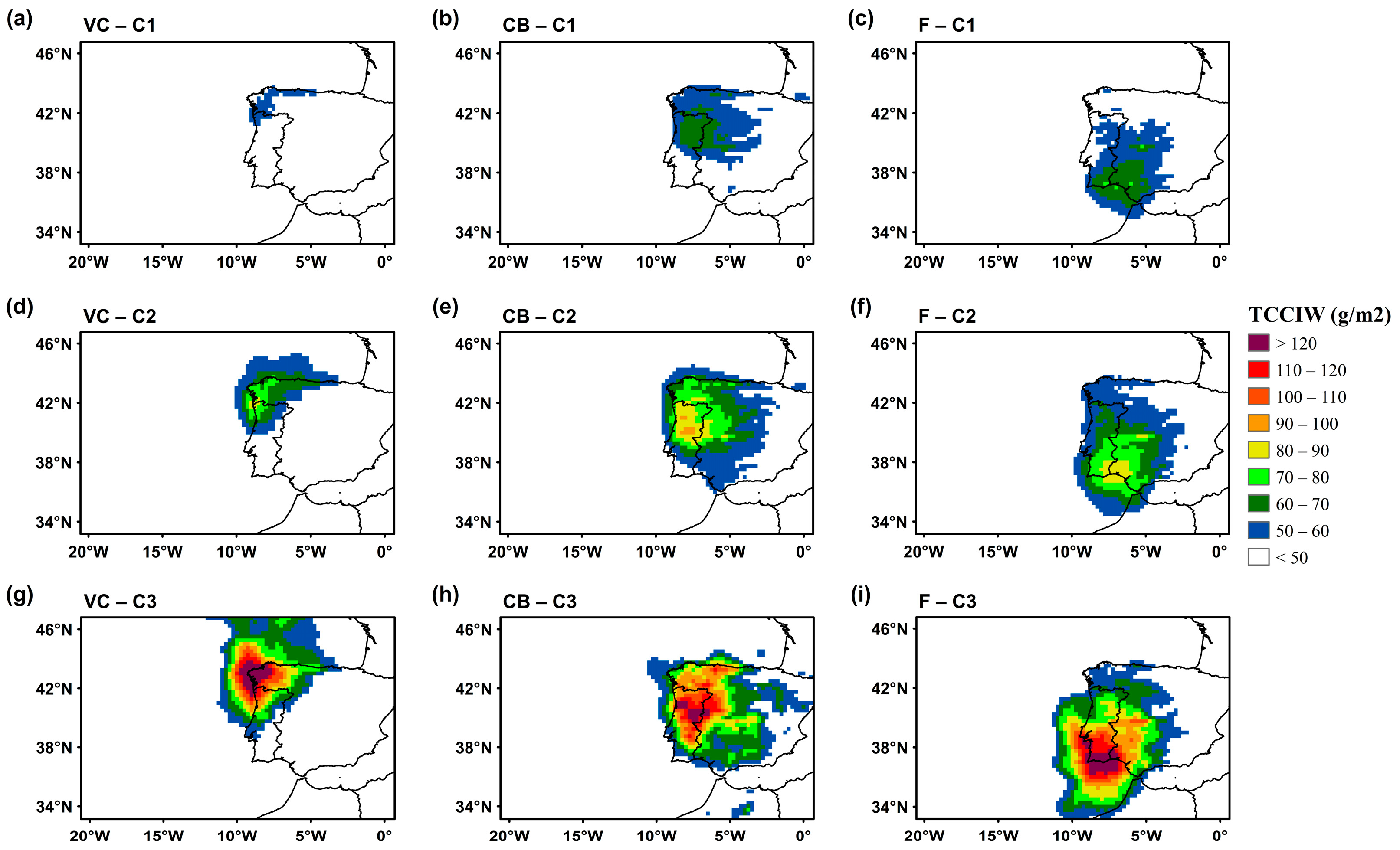
Disclaimer/Publisher’s Note: The statements, opinions and data contained in all publications are solely those of the individual author(s) and contributor(s) and not of MDPI and/or the editor(s). MDPI and/or the editor(s) disclaim responsibility for any injury to people or property resulting from any ideas, methods, instructions or products referred to in the content. |
© 2023 by the authors. Licensee MDPI, Basel, Switzerland. This article is an open access article distributed under the terms and conditions of the Creative Commons Attribution (CC BY) license (https://creativecommons.org/licenses/by/4.0/).
Share and Cite
Cruz, J.; Belo-Pereira, M.; Fonseca, A.; Santos, J.A. Dynamic and Thermodynamic Drivers of Severe Sub-Hourly Precipitation Events in Mainland Portugal. Atmosphere 2023, 14, 1443. https://doi.org/10.3390/atmos14091443
Cruz J, Belo-Pereira M, Fonseca A, Santos JA. Dynamic and Thermodynamic Drivers of Severe Sub-Hourly Precipitation Events in Mainland Portugal. Atmosphere. 2023; 14(9):1443. https://doi.org/10.3390/atmos14091443
Chicago/Turabian StyleCruz, José, Margarida Belo-Pereira, André Fonseca, and João A. Santos. 2023. "Dynamic and Thermodynamic Drivers of Severe Sub-Hourly Precipitation Events in Mainland Portugal" Atmosphere 14, no. 9: 1443. https://doi.org/10.3390/atmos14091443




